Abstract
The contribution of urease activity to the pathogenesis of Actinobacillus pleuropneumoniae was investigated using 2 different urease-negative transposon mutants of the virulent serotype 1 strain, CM5 Nalr. One mutant, cbiK::Tn10, is deficient in the uptake of nickel, a cofactor required for urease activity. The other mutant, ureG::Tn10, is unable to produce active urease due to mutation of the urease accessory gene, ureG. In aerosol challenge experiments, pigs developed acute pleuropneumonia following exposure to high doses (10(6) cfu/mL) of the parental strain, CM5 Nalr, and to the cbiK::Tn10 mutant. When low dose (10(3) cfu/mL) challenges were used, neither urease-negative mutant was able to establish infection, whereas the parental strain was able to colonize and cause lesions consistent with acute pleuropneumonia in 8 of the 20 pigs challenged. These findings suggest that urease activity may be needed for A. pleuropneumoniae to establish infection in the respiratory tract of pigs.
Full text
PDF
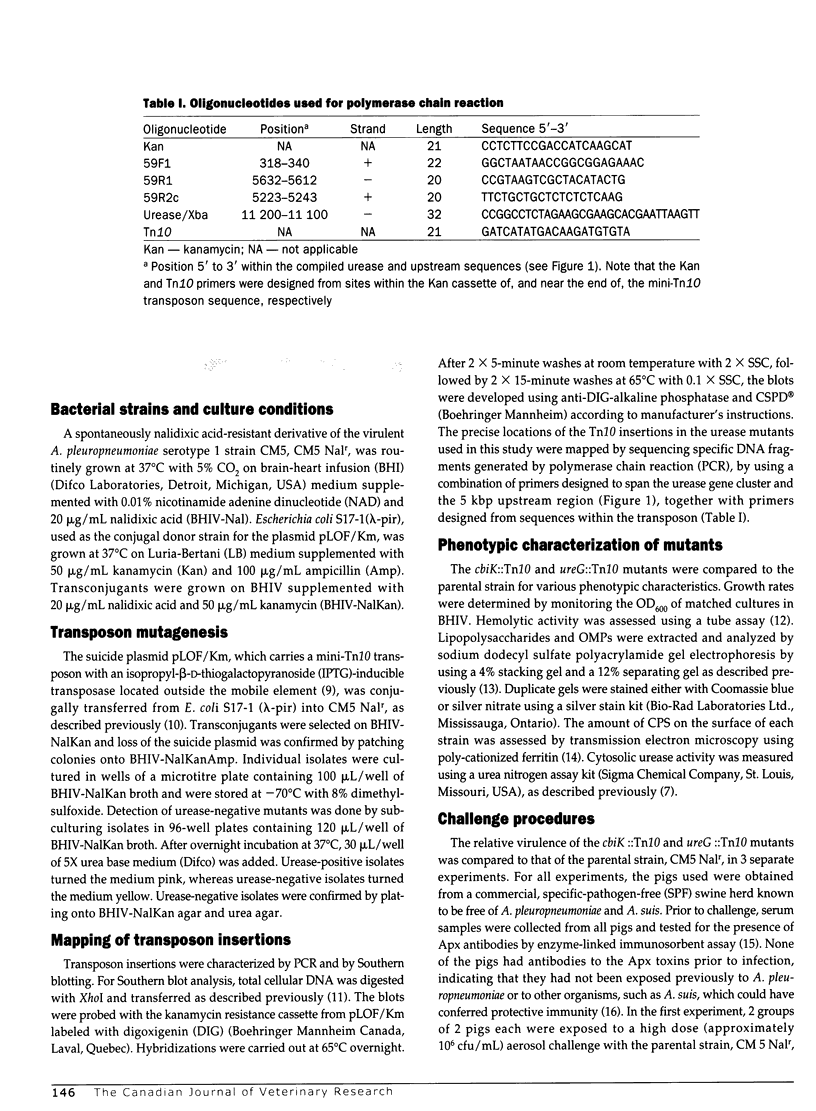
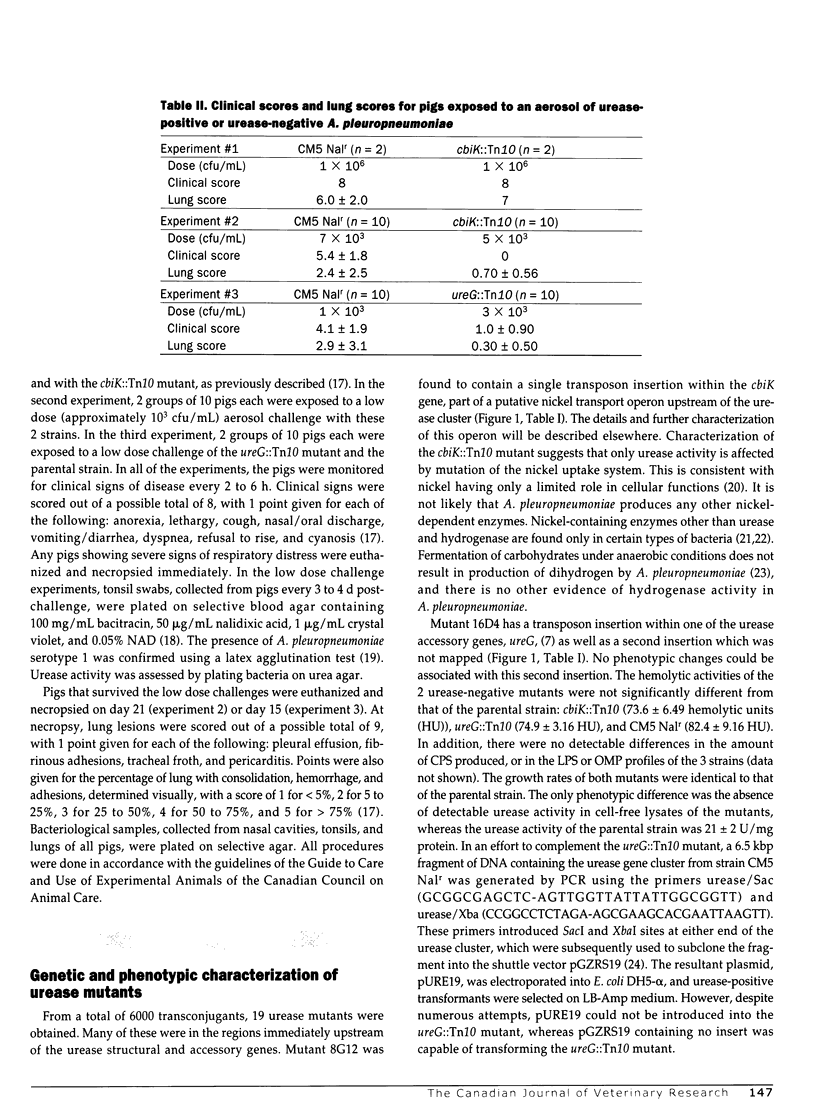
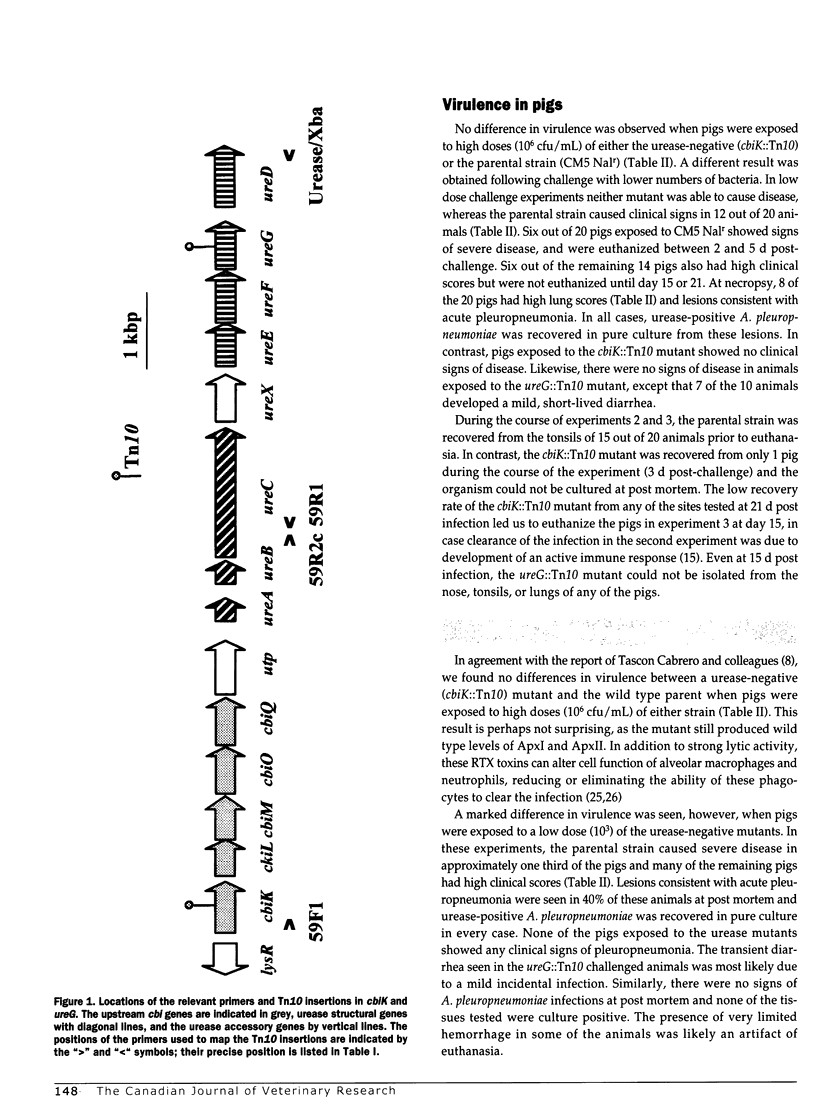
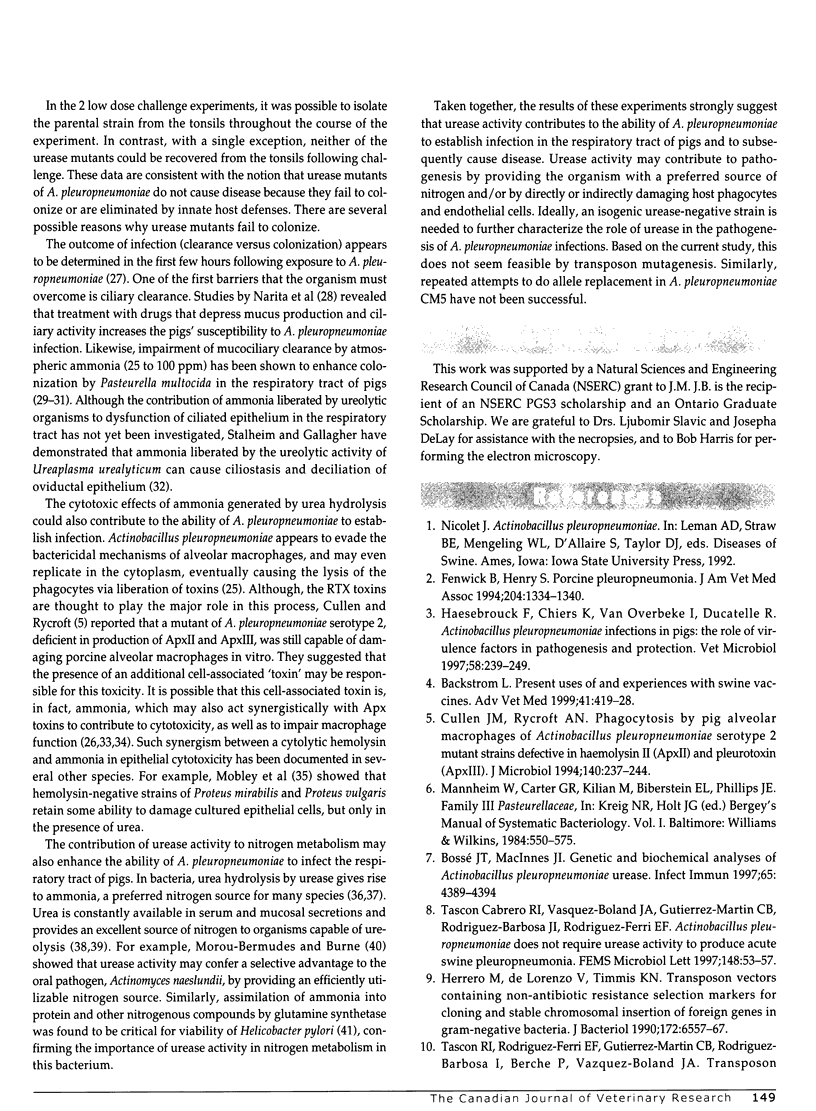
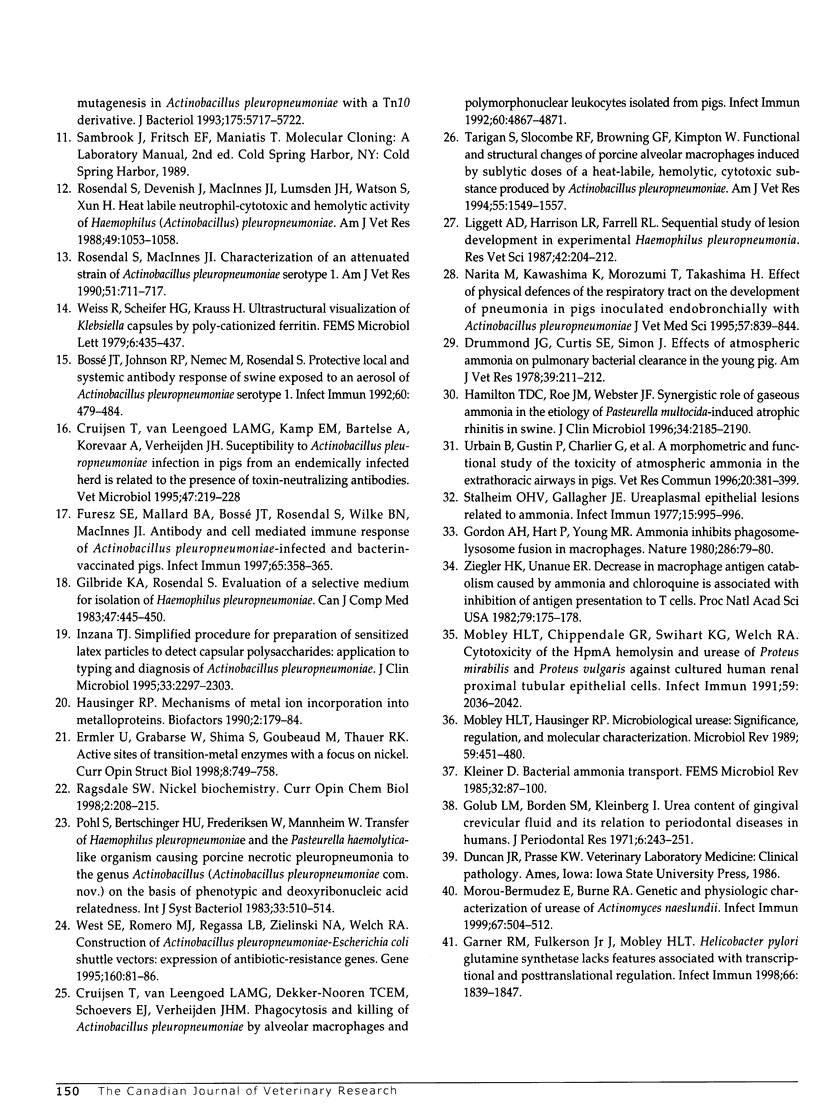
Selected References
These references are in PubMed. This may not be the complete list of references from this article.
- Bossé J. T., Johnson R. P., Nemec M., Rosendal S. Protective local and systemic antibody responses of swine exposed to an aerosol of Actinobacillus pleuropneumoniae serotype 1. Infect Immun. 1992 Feb;60(2):479–484. doi: 10.1128/iai.60.2.479-484.1992. [DOI] [PMC free article] [PubMed] [Google Scholar]
- Bossé J. T., MacInnes J. I. Genetic and biochemical analyses of Actinobacillus pleuropneumoniae urease. Infect Immun. 1997 Nov;65(11):4389–4394. doi: 10.1128/iai.65.11.4389-4394.1997. [DOI] [PMC free article] [PubMed] [Google Scholar]
- Bäckström L. Present uses of and experiences with swine vaccines. Adv Vet Med. 1999;41:419–428. doi: 10.1016/s0065-3519(99)80032-9. [DOI] [PubMed] [Google Scholar]
- Cruijsen T. L., Van Leengoed L. A., Dekker-Nooren T. C., Schoevers E. J., Verheijden J. H. Phagocytosis and killing of Actinobacillus pleuropneumoniae by alveolar macrophages and polymorphonuclear leukocytes isolated from pigs. Infect Immun. 1992 Nov;60(11):4867–4871. doi: 10.1128/iai.60.11.4867-4871.1992. [DOI] [PMC free article] [PubMed] [Google Scholar]
- Cruijsen T., van Leengoed L. A., Kamp E. M., Bartelse A., Korevaar A., Verheijden J. H. Susceptibility to Actinobacillus pleuropneumoniae infection in pigs from an endemically infected herd is related to the presence of toxin-neutralizing antibodies. Vet Microbiol. 1995 Dec;47(3-4):219–228. doi: 10.1016/0378-1135(95)00109-3. [DOI] [PubMed] [Google Scholar]
- Cullen J. M., Rycroft A. N. Phagocytosis by pig alveolar macrophages of Actinobacillus pleuropneumoniae serotype 2 mutant strains defective in haemolysin II (ApxII) and pleurotoxin (ApxIII). Microbiology. 1994 Feb;140(Pt 2):237–244. doi: 10.1099/13500872-140-2-237. [DOI] [PubMed] [Google Scholar]
- Drummond J. G., Curtis S. E., Simon J. Effects of atmospheric ammonia on pulmonary bacterial clearance in the young pig. Am J Vet Res. 1978 Feb;39(2):211–212. [PubMed] [Google Scholar]
- Ermler U., Grabarse W., Shima S., Goubeaud M., Thauer R. K. Active sites of transition-metal enzymes with a focus on nickel. Curr Opin Struct Biol. 1998 Dec;8(6):749–758. doi: 10.1016/s0959-440x(98)80095-x. [DOI] [PubMed] [Google Scholar]
- Fenwick B., Henry S. Porcine pleuropneumonia. J Am Vet Med Assoc. 1994 May 1;204(9):1334–1340. [PubMed] [Google Scholar]
- Furesz S. E., Mallard B. A., Bossé J. T., Rosendal S., Wilkie B. N., MacInnes J. I. Antibody- and cell-mediated immune responses of Actinobacillus pleuropneumoniae-infected and bacterin-vaccinated pigs. Infect Immun. 1997 Feb;65(2):358–365. doi: 10.1128/iai.65.2.358-365.1997. [DOI] [PMC free article] [PubMed] [Google Scholar]
- Garner R. M., Fulkerson J., Jr, Mobley H. L. Helicobacter pylori glutamine synthetase lacks features associated with transcriptional and posttranslational regulation. Infect Immun. 1998 May;66(5):1839–1847. doi: 10.1128/iai.66.5.1839-1847.1998. [DOI] [PMC free article] [PubMed] [Google Scholar]
- Gilbride K. A., Rosendal S. Evaluation of a selective medium for isolation of Haemophilus pleuropneumoniae. Can J Comp Med. 1983 Oct;47(4):445–450. [PMC free article] [PubMed] [Google Scholar]
- Golub L. M., Borden S. M., Kleinberg I. Urea content of gingival crevicular fluid and its relation to periodontal diseases in humans. J Periodontal Res. 1971;6(4):243–251. doi: 10.1111/j.1600-0765.1971.tb00615.x. [DOI] [PubMed] [Google Scholar]
- Gordon A. H., Hart P. D., Young M. R. Ammonia inhibits phagosome-lysosome fusion in macrophages. Nature. 1980 Jul 3;286(5768):79–80. doi: 10.1038/286079a0. [DOI] [PubMed] [Google Scholar]
- Haesebrouck F., Chiers K., Van Overbeke I., Ducatelle R. Actinobacillus pleuropneumoniae infections in pigs: the role of virulence factors in pathogenesis and protection. Vet Microbiol. 1997 Nov;58(2-4):239–249. doi: 10.1016/s0378-1135(97)00162-4. [DOI] [PubMed] [Google Scholar]
- Hamilton T. D., Roe J. M., Webster A. J. Synergistic role of gaseous ammonia in etiology of Pasteurella multocida-induced atrophic rhinitis in swine. J Clin Microbiol. 1996 Sep;34(9):2185–2190. doi: 10.1128/jcm.34.9.2185-2190.1996. [DOI] [PMC free article] [PubMed] [Google Scholar]
- Hausinger R. P. Mechanisms of metal ion incorporation into metalloproteins. Biofactors. 1990 Jul;2(3):179–184. [PubMed] [Google Scholar]
- Herrero M., de Lorenzo V., Timmis K. N. Transposon vectors containing non-antibiotic resistance selection markers for cloning and stable chromosomal insertion of foreign genes in gram-negative bacteria. J Bacteriol. 1990 Nov;172(11):6557–6567. doi: 10.1128/jb.172.11.6557-6567.1990. [DOI] [PMC free article] [PubMed] [Google Scholar]
- Inzana T. J. Simplified procedure for preparation of sensitized latex particles to detect capsular polysaccharides: application to typing and diagnosis of Actinobacillus pleuropneumoniae. J Clin Microbiol. 1995 Sep;33(9):2297–2303. doi: 10.1128/jcm.33.9.2297-2303.1995. [DOI] [PMC free article] [PubMed] [Google Scholar]
- Liggett A. D., Harrison L. R., Farrell R. L. Sequential study of lesion development in experimental haemophilus pleuropneumonia. Res Vet Sci. 1987 Mar;42(2):204–212. [PubMed] [Google Scholar]
- Mobley H. L., Chippendale G. R., Swihart K. G., Welch R. A. Cytotoxicity of the HpmA hemolysin and urease of Proteus mirabilis and Proteus vulgaris against cultured human renal proximal tubular epithelial cells. Infect Immun. 1991 Jun;59(6):2036–2042. doi: 10.1128/iai.59.6.2036-2042.1991. [DOI] [PMC free article] [PubMed] [Google Scholar]
- Mobley H. L., Island M. D., Hausinger R. P. Molecular biology of microbial ureases. Microbiol Rev. 1995 Sep;59(3):451–480. doi: 10.1128/mr.59.3.451-480.1995. [DOI] [PMC free article] [PubMed] [Google Scholar]
- Morou-Bermudez E., Burne R. A. Genetic and physiologic characterization of urease of Actinomyces naeslundii. Infect Immun. 1999 Feb;67(2):504–512. doi: 10.1128/iai.67.2.504-512.1999. [DOI] [PMC free article] [PubMed] [Google Scholar]
- Narita M., Kawashima K., Morozumi T., Takashima H. Effect of physical defenses of the respiratory tract on the development of pneumonia in pigs inoculated endobronchially with Actinobacillus pleuropneumoniae. J Vet Med Sci. 1995 Oct;57(5):839–844. doi: 10.1292/jvms.57.839. [DOI] [PubMed] [Google Scholar]
- Ragsdale S. W. Nickel biochemistry. Curr Opin Chem Biol. 1998 Apr;2(2):208–215. doi: 10.1016/s1367-5931(98)80062-8. [DOI] [PubMed] [Google Scholar]
- Rosendal S., Devenish J., MacInnes J. I., Lumsden J. H., Watson S., Xun H. Evaluation of heat-sensitive, neutrophil-toxic, and hemolytic activity of Haemophilus (Actinobacillus) pleuropneumoniae. Am J Vet Res. 1988 Jul;49(7):1053–1058. [PubMed] [Google Scholar]
- Rosendal S., MacInnes J. I. Characterization of an attenuated strain of Actinobacillus pleuropneumoniae, serotype 1. Am J Vet Res. 1990 May;51(5):711–717. [PubMed] [Google Scholar]
- Stalheim O. H., Gallagher J. E. Ureaplasmal epithelial lesions related to ammonia. Infect Immun. 1977 Mar;15(3):995–996. doi: 10.1128/iai.15.3.995-996.1977. [DOI] [PMC free article] [PubMed] [Google Scholar]
- Tarigan S., Slocombe R. F., Browning G. F., Kimpton W. Functional and structural changes of porcine alveolar macrophages induced by sublytic doses of a heat-labile, hemolytic, cytotoxic substance produced by Actinobacillus pleuropneumoniae. Am J Vet Res. 1994 Nov;55(11):1548–1557. [PubMed] [Google Scholar]
- Tascón Cabrero R. I., Vázquez-Boland J. A., Gutiérrez C. B., Rodríguez-Barbosa J. I., Rodríguez-Ferri E. F. Actinobacillus pleuropneumoniae does not require urease activity to produce acute swine pleuropneumonia. FEMS Microbiol Lett. 1997 Mar 1;148(1):53–57. doi: 10.1111/j.1574-6968.1997.tb10266.x. [DOI] [PubMed] [Google Scholar]
- Urbain B., Gustin P., Charlier G., Coignoul F., Lambotte J. L., Grignon G., Foliguet B., Vidic B., Beerens D., Prouvost J. F. A morphometric and functional study of the toxicity of atmospheric ammonia in the extrathoracic airways in pigs. Vet Res Commun. 1996;20(4):381–399. doi: 10.1007/BF00366545. [DOI] [PubMed] [Google Scholar]
- West S. E., Romero M. J., Regassa L. B., Zielinski N. A., Welch R. A. Construction of Actinobacillus pleuropneumoniae-Escherichia coli shuttle vectors: expression of antibiotic-resistance genes. Gene. 1995 Jul 4;160(1):81–86. doi: 10.1016/0378-1119(95)00236-y. [DOI] [PubMed] [Google Scholar]
- Ziegler H. K., Unanue E. R. Decrease in macrophage antigen catabolism caused by ammonia and chloroquine is associated with inhibition of antigen presentation to T cells. Proc Natl Acad Sci U S A. 1982 Jan;79(1):175–178. doi: 10.1073/pnas.79.1.175. [DOI] [PMC free article] [PubMed] [Google Scholar]


